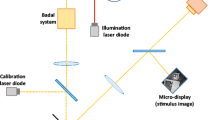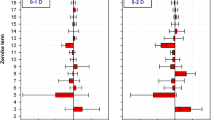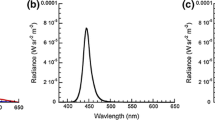Abstract
The present review aims to discuss the current researches on the ability of the vergence system to adjust to new information. A concomitant or non-concomitant binocular retinal disparity caused by a prism or an anisometropic prescription can be adapted to such that the induced phoria of fixation disparity reduces back to the original value. The features and mechanisms of this normal adaptation and also the response in subjects with abnormal binocular vision are discussed. The less extensive work on the adaptive ability of the accommodative vergence system is also reviewed.
Similar content being viewed by others
References
Abel LA, Schmidt D, Dell'Osso LF and Daroff RB (1978) Saccadic system plasticity in humans. Ann Neur 4:313–318
Allen DC (1974) Vertical prism adaptation in anisometropes. Amer J Optom Phys Optics 51:252–259
Balsam MH and Fry GA (1959) Convergence-accommodation. Amer J Optom Arch Amer Acad Optom 36:567
Burg A (1968) Horizontal phoria is related to age and sex. Amer J Optom Arch Amer Acad Optom 45:345
Carter DB (1957) Studies of fixation disparity: Historical review. Amer J Optom Arch Amer Acad Optom 34:320–329
Carter DB (1963) Effects of prolonged wearing of prism. Amer J Optom Phys Optics 40:265–273
Carter DB (1964) Fixation disparity with and without foveal fusion targets. Amer J Optom Arch Amer Acad Optom 41:729–736
Carter DB (1965) Fixation disparity and heterophoria following prolonged wearing of prism. Amer J Optom Arch Amer Acad Optom 42:141–152
Chamberlain W (1971) Restriction in upward gaze with advancing age. Amer J Ophthal 71:341–346
Cusick PL and Hawn HW (1941) Prism compensation in cases of anisometropia. Arch Oph 25:651
Dharamshi BG (1983) Adaptation to prism induced comitant and incomitant disparities. PhD Thesis. University of Wales Institute of Science and Technology, Cardiff
Ellerbrock VJ (1948) Further study of effects induced by anisometropic corrections. Amer J Optom Arch Amer Acad Optom 25:430–437
Ellerbrock VJ (1950) Tonicity induced by fusional movements. Amer J Optom Arch Amer Acad Optom 27:8–20
Ellerbrock VJ and Fry GA (1942) Effects induced by anisometropic corrections. Amer J Optom Arch Amer Acad Optom 19:444–459
Flom MC and Takahashi E (1962) The AC/A ratio and uncorrected myopia. Amer J Optom Arch Amer Acad Optom 39:305–319
Gauthier GM and Robinson DA (1975) Adaptation of the human vestibulocular reflex to magnifying lenses. Brain Res 92:331–335
Gonshor A and Melvill Jones G (1971) Plasticity in the adult human vestibulocular reflex arc. Proc Can Fed Biol Sci 14:11
Henson DB (1978) Corrective saccades: effects of altering visual feedback. Vision Res 18:63–67
Henson DB and Dharamshi BG (1982a) Oculomotor adaptation to induced heterophoria and anisometropia. Invest Ophthal Vis Sci 22:234–240
Henson DB and Dharamshi BG (1982b) Binocular oculomotor adaptation to induced incomitant deviations. In: Functional basis of ocular motility disorder. Wenner-Gren Symposium series. Vol. 37, pp 229–231, Eds G Lennerstrand, DS Zee and EL Keller. Oxford, Pergamon Press
Henson DB and North RV (1980) Adaptation to prism-induced heterophoria. Amer J Optom Physiol Opt 57:127–137
Hirsch MJ, Alpern M and Schultz HL (1948) The variation of phoria with age. Amer J Optom Arch Amer Acad Optom 25:535
Kephart NC and Oliver JE (1952) A study of the relationship between lateral phoria and age. Amer J Optom Arch Amer Acad Optom 29:423
Kommerell G, Olivier D and Theopold H (1976) Adaptive programming of phasic and tonic components in saccadic eye movements. Investigations in patients with abducens palsy. Invest Ophthal 15:657–660
Ludvigh E and McKinnon P (1966) Relative effectivity of foveal and parafoveal stimuli in eliciting fusion movements of amplitudes. AMA Arch Ophthal 76:443–446
Ludvigh E, McKinnon P and Zaitzeff L (1964) Temporal course of the relaxation of binocular duction (fusion) movements. Arch Ophthal 71:389–399
Miles FA and Fuller JH (1974) Adaptive plasticity in the vestibulocular responses of the rhesus monkey. Brain Res 80:512
Miles FA and Judge SJ (1982) Optically-induced changes in the neural coupling between vergence eye movements and accommodation in human subjects. In: Functional basis of ocular motility disorder. Wenner-Gren Symposium series, vol. 37, pp 93–96, Eds G Lennerstrand, DS Zee and EL Keller, Oxford, Pergamon Press
Miller JE (1975) Aging changes of ocular motility and their clinical implications. Wenner-Gren centre international symposium series, vol. 24, pp. 47–63, Oxford, Pergamon Press
Mitchell A and Ellerbrock VJ (1955) Fixation disparity and the maintenance of fusion in the horizontal meridian. Amer J Optom Arch Amer Acad Optom 32:520–534
Morgan MW (1954) The ciliary muscular force required for accommodation. J Phys 128:219
Morgan MW (1960) Anomalies of the visual neuromuscular system of the aging patient and their correction. In: Vision of the aging patient. Philadelphia, Chilton Books
North RV and Henson DB (1981) Adaptation to prism-induced heterophoria in subjects with abnormal binocular vision or asthenopia. Amer J Optom Phys Opt 59:746–752
North RV and Henson DB (1982) Effect of orthoptics upon the ability of patients to adapt to prism-induced heterophoria. Amer J Optom Phys Opt 61:506–512
North RV and Henson DB (1985) Adaptation to lens induced heterophorias. Amer J Optom Phys Opt 62:774–780
Ogle KN (1964) Researches in Binocular Vision, p. 76–81 Hafner (New York)
Ogle KN and Prangen A de H (1953) Observations on vertical divergences and hyperiphorias. Arch Ophthal 49:313–334
Ogle KN, Martens TG and Dyer JA (1967) Oculomotor imbalance in binocular vision and fixation disparity. Henry Kimpton (London)
Optican LM and Robinson DA (1980) Cerebellar-dependent adaptive control of primate saccadic system. J Neuro physiol 44:1058–1076
Pascal JI (1949) Compensatory imbalance in correcting anisometropia. Opt World 37(8): 23
Rashbass C and Westheimer G (1961) Disjunctive eye movements. J Physiol (London) 159:339–360
Robinson DA (1976) Adaptive gain control of the vestibulo-ocular reflex by the cerebellum. J Neurol 39:954–969
Rutstein RP and Eskridge JB (1985) Clinical evaluation of vertical fixation disparity. Part III. Adaptation to vertical prism. Amer J Optom Physiol Opt 62:585–590
Schor CM (1979) The influence of rapid prism adaptation upon fixation disparity. Vision Res 19:757–765
Scobee RG and Bennet EA (1950) Hyperphoria, a statistical study. Arch Ophthal 43:458
Sethi B (1986) Heterophoria: A vergence adaptive position. Ophth and Phys Optics 6(2):151–156
Sethi B and Henson DB (1984) Adaptive changes with prolonged effect of comitance and incomitance vergence disparities. Amer J Optom Physiol Opt 61:506–512
Sethi B and Henson DB (1985) Vergence-adaptive change with a prism-induced non comitant disparity. Amer J Optom Physiol Opt 62:207–216
Sethi B and North RV (1986) Vergence adaptive changes with varying magnitudes of prism-induced disparities and fusional amplitudes. (submitted to Amer J Optom Physiol Opt)
Weale RA (1963) The aging eye. London, HK Lewis
Westheimer G and Mitchell AM (1956) Eye movements responses to convergence stimuli. A M A Arch Ophthal 55:848–856.
Author information
Authors and Affiliations
Additional information
(Nee Dharamshi)
Rights and permissions
About this article
Cite this article
Sethi, B. Vergence adaptation: a review. Doc Ophthalmol 63, 247–263 (1986). https://doi.org/10.1007/BF00160760
Issue Date:
DOI: https://doi.org/10.1007/BF00160760




